Canon POWERSHOT SX20 Manual
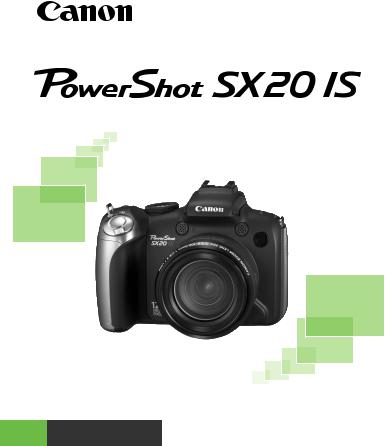
Camera User Guide
ENGLISH
•Make sure you read this guide before using the camera.
•Store this guide safely so that you can use it in the future.
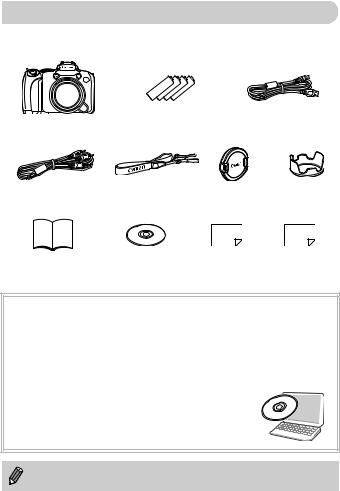
Checking the Package Contents
Check if the following items are included in your camera package. If anything is missing, contact the retailer from which you purchased the camera.
Camera |
AA-size Alkaline |
Interface Cable |
Batteries (×4) |
IFC-400PCU |
Stereo Video |
Neck Strap NS-DC4 |
Lens Cap |
Lens Hood |
Cable STV-250N |
|
|
LH-DC50 |
Getting Started |
DIGITAL CAMERA |
Warranty |
“Canon Customer |
|
Solution Disk |
Card |
Support” Leaflet |
Using the PDF Manuals
Also refer to the PDF manuals on the CD-ROM. After installation, shortcut icons appear on the desktop. If the software installation fails, you can find the manuals in the Readme folder on the CD-ROM.
•Camera User Guide (This Guide)
Once you have mastered the basics, use the camera’s many features to shoot more challenging photos.
•Personal Printing Guide
Read when you want to connect the camera to a printer (sold separately) and print.
• Software Guide
Read when you want to use the included software.
• A memory card is not included.
• Adobe Reader is required to view the PDF manuals.
2

Read This First
Test Shots
Take some initial test shots and play them back to make sure the images were recorded correctly. Please note that Canon Inc., its subsidiaries and affiliates, and its distributors are not liable for any consequential damages arising from any malfunction of a camera or accessory, including memory cards, that results in the failure of an image to be recorded or to be recorded in a way that is machine readable.
Warning Against Copyright Infringement
The images recorded with this camera are intended for personal use. Do not record images that infringe upon copyright laws without the prior permission of the copyright holder. Please be advised that in certain cases the copying of images from performances, exhibitions, or commercial properties by means of a camera or other device may contravene copyright or other legal rights even if the image was shot for personal use.
Warranty Limitations
This camera’s warranty is only effective in the country of sale. If there is a problem with the camera while abroad, please return it to the country of sale before proceeding with a warranty claim to a Canon Customer Support Help Desk. For Canon Customer Support contacts, please see the customer support list supplied with your camera.
LCD Monitor
•The LCD monitor and viewfinder are produced with extremely highprecision manufacturing techniques. More than 99.99% of the pixels operate to specification, but occasionally non-performing pixels may appear as bright or dark dots. This is not a malfunction and has no effect on the recorded image.
•The LCD monitor may be covered with a thin plastic film for protection against scratches during shipment. If so, remove the film before using the camera.
Camera Body Temperature
Please take care when operating the camera for an extended period as the camera body may become warm. This is not a malfunction.
Memory Cards
The various types of memory cards that can be used in this camera are collectively referred to as memory cards in this guide.
3
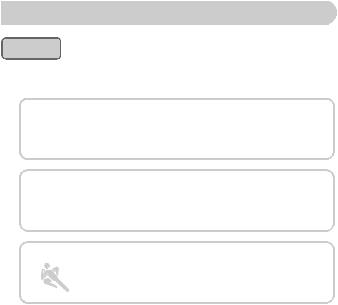
What Do You Want to Do?
Shoot 4
● Shoot, leaving it to the camera to make settings . . . . . . . . . . . . 24 ● Shoot to match special conditions. . . . . . . . . . . . . . . . . . . . 58 – 61
Take good people shots |
|
|
w |
P |
||
I |
F |
|
|
|||
Portraits |
At night |
|
At the beach |
Against snow |
||
(p. 58) |
(p. 58) |
|
|
(p. 60) |
(p. 61) |
|
Take good landscapes |
|
|
, |
O |
||
J U |
|
|
||||
Landscape |
Sunsets |
Night Scene |
Foliage |
|||
(p. 58) |
(p. 59) |
|
(p. 60) |
(p. 60) |
||
Shoot various other scenes |
t |
|
Z |
|||
|
’ |
Aquarium |
||||
Sports |
Indoors |
Fireworks |
Low light |
|||
y |
||||||
(p. 58) |
(p. 59) |
|
(p. 60) |
(p. 60) |
(p. 61) |
|
● Focus on faces . . . . . . . . . . . . . . . . . . . . . . . . . . . . . 24, 66, 82, 86 ● Shoot in places where I cannot use the flash
(turn off the flash) . . . . . . . . . . . . . . . . . . . . . . . . . . . . . . . . . . . . 25 ● Take pictures with me in them too (self-timer) . . . . . . . . . . . 65, 66 ● Insert the date and time into my shots . . . . . . . . . . . . . . . . . . . . 64 ● Take close-up pictures of subjects (macro shooting) . . . . . . . . . 72 ● Take sepia toned or black and white pictures . . . . . . . . . . . . . . . 76 ● Change the size of picture I want to take (recording pixels) . . . . 70 ● Take pictures continuously . . . . . . . . . . . . . . . . . . . . . . . . . . . . . 75 ● Shoot without the effects of camera shake (image stabilization) . . 149 ● Shoot without the effects of camera shake even in low light
conditions (High ISO Auto) . . . . . . . . . . . . . . . . . . . . . . . . . . 61, 73 ● Maintain the focus on moving subjects (Servo AF). . . . . . . . . . . 85 ● Make dark subjects appear brighter (i-Contrast). . . . . . . . . . . . . 96
4

What Do You Want to Do? |
|
View |
|
● Look at my pictures. . . . . . . . . . . . . . . . . . . . . . . . |
. . . . . . . . . . . 27 |
● Automatically play back pictures (slideshow) . . . . . |
.1. . . . . . . . 119 |
● Look at my pictures on a TV . . . . . . . . . . . . . . . . . . |
. . . . . . . . . 122 |
● Quickly search pictures . . . . . . . . . . . . . . . . . . . . . . |
. . . . . 116, 117 |
● Erase pictures . . . . . . . . . . . . . . . . . . . . . . . . . . . . . |
. . . . . . 28, 127 |
● Protect pictures from accidental erasure. . . . . . . . . |
. . . . . . . . . 124 |
Shoot/View Movies |
|
● Shoot movies . . . . . . . . . . . . . . . . . . . . . . . . . . . . . |
. . . . . . . . . . 31 |
● View movies . . . . . . . . . . . . . . . . . . . . . . . . . . . . . . |
E. . . . . . . . . . 33 |
|
2 |
|
|
● Easily print pictures. . . . . . . . . . . . . . . . . . . . . . . . . |
. . . . . . . . . . 29 |
Save |
|
● Save images to a computer |
. . . . . . . . . . . . . . . . . . . . . . . . . . . . 34 |
Other |
|
● Turn off sounds . . . . . . . . . . . . . . . . . . . . . . . . . . . . . |
. . . . . . . . . 50 |
● Use the camera abroad. . . . . . . . . . . . . . . . . . . . . . . |
3. . . . . . . . 143 |
5

Table of Contents
Chapters 1 – 3 explain the basic operations and frequently used functions of this camera. Chapters 4 onward explain the advanced functions, letting you learn more as you read each chapter.
Checking the Package Contents ....... |
2 |
Read This First .................................. |
3 |
What Do You Want to Do? ................ |
4 |
Conventions Used in this Guide ........ |
9 |
Safety Precautions........................... |
10 |
1 Getting Started .................... |
13 |
Inserting the Batteries...................... |
14 |
Inserting the Memory |
|
Card ................................................. |
16 |
Opening the LCD Monitor ................ |
18 |
Setting the Date and Time ............... |
19 |
Setting the Display Language.......... |
21 |
Formatting Memory Cards ............... |
22 |
Pressing the Shutter Button............. |
23 |
Taking Pictures................................ |
24 |
Viewing Images ............................... |
27 |
Erasing Images................................ |
28 |
Printing Images................................ |
29 |
Shooting Movies .............................. |
31 |
Viewing Movies................................ |
33 |
Transferring Images |
|
to a Computer .................................. |
34 |
Accessories ..................................... |
38 |
Separately Sold Accessories ........... |
40 |
2 Learning More...................... |
41 |
Components Guide.......................... |
42 |
Information Displayed |
|
on the Screen .................................. |
44 |
Indicators ......................................... |
47 |
FUNC. Menu – Basic Operations .... |
48 |
Menu – Basic Operations ................ |
49 |
6
Changing the Sound Settings ......... |
50 |
Changing the Screen Brightness .... |
51 |
Returning the Camera to Default |
|
Settings ........................................... |
52 |
Low Level Memory Card |
|
Formatting ....................................... |
53 |
Power Saving Function |
|
(Auto Power Down) ......................... |
54 |
Clock Functions............................... |
54 |
Adjusting the Viewfinder.................. |
55 |
Attaching the Lens Hood................. |
55 |
3Shooting in Special Conditions and Commonly
Used Functions................... |
57 |
Shooting in Various Conditions ....... |
58 |
Shooting in Special Scenes ............ |
59 |
Zooming in More Closely on |
|
Subjects (Digital Zoom)................... |
62 |
Inserting the Date and Time............ |
64 |
Using the Self-Timer ....................... |
65 |
Using the Face Self-Timer .............. |
66 |
4 Choosing Settings |
|
Yourself ............................... |
67 |
Shooting in Program AE.................. |
68 |
Adjusting the Brightness |
|
(Exposure Compensation) .............. |
69 |
Turning the Flash On ...................... |
69 |
Changing the Recording Pixels |
|
(Image Size).................................... |
70 |
Changing the Compression Ratio |
|
(Image Quality)................................ |
70 |

Shooting Close-ups |
|
(Macro/Super Macro)...................... |
72 |
Changing the ISO Speed................ |
73 |
Adjusting the White Balance........... |
74 |
Continuous Shooting....................... |
75 |
Changing the Tone of an Image |
|
(My Colors) ..................................... |
76 |
Shooting Using the Two Second |
|
Self-Timer ....................................... |
77 |
Customizing the Self-Timer............. |
78 |
Shooting Using a TV Monitor.......... |
79 |
Changing the Composition |
|
with the Focus Lock ........................ |
79 |
5 Getting More Out of Your |
|
Camera ................................ |
81 |
Changing the AF Frame Mode........ |
82 |
Changing the AF Frame |
|
Position and Size ............................ |
83 |
Magnifying the Focal Point.............. |
84 |
Shooting with the AF Lock .............. |
85 |
Shooting with Servo AF .................. |
85 |
Choosing the Person to |
|
Focus On (Face Select).................. |
86 |
Changing the Metering Mode.......... |
87 |
Shooting in Manual Focus Mode .... |
88 |
Focus Bracketing |
|
(Focus-BKT Mode).......................... |
89 |
Shooting with the AE Lock.............. |
90 |
Shooting with the FE Lock .............. |
91 |
Auto Exposure Bracketing |
|
(AEB Mode) .................................... |
91 |
Shooting with Slow Synchro ........... |
92 |
Setting the Shutter Speed............... |
93 |
Setting the Aperture Value.............. |
94 |
Setting the Shutter Speed and |
|
Aperture Value................................ |
95 |
Table of Contents |
|
Correcting the Brightness and |
|
Shooting (i-Contrast) ....................... |
96 |
Red-Eye Correction......................... |
97 |
Adjusting the Flash Exposure |
|
Compensation ................................. |
98 |
Adjusting the Flash Output .............. |
99 |
Changing the Flash Timing ........... |
100 |
Checking for Shut Eyes................. |
101 |
Registering Shooting Settings ....... |
102 |
Changing the Color and |
|
Shooting ........................................ |
103 |
Shooting Stitch Assist Images....... |
105 |
6 Using Various Functions |
|
for Shooting Movies ......... |
107 |
Changing the Image Quality.......... |
108 |
Taking Still Images while |
|
Shooting a Movie........................... |
109 |
Sound Settings .............................. |
110 |
AE Lock/Exposure Shift................. |
111 |
Other Shooting Functions.............. |
111 |
Playback Functions ....................... |
112 |
Editing ........................................... |
113 |
7 Using Playback and Other |
|
Functions........................... |
115 |
Quickly Searching Images............. |
116 |
Viewing Images in Filtered |
|
Playback........................................ |
117 |
Viewing Slideshows....................... |
119 |
Checking the Focus....................... |
120 |
Magnifying Images ........................ |
121 |
Changing Image Transitions ......... |
121 |
Viewing Images on a TV ............... |
122 |
Viewing Images on |
|
a High-Definition TV ...................... |
123 |
Protecting Images ......................... |
124 |
7

|
|
Table of Contents |
|
|
|
|
|
|
.........................Erasing All Images |
127 |
|
|
|
|
|
9 Useful Information |
155 |
|||
|
|
Organizing Images by Category |
|
|
||
|
|
|
|
Replacing the Date/Time |
|
|
|
|
(My Category) ................................ |
129 |
|
||
|
|
Rotating Images............................. |
131 |
|
Battery........................................... |
156 |
|
|
Resizing Images ............................ |
132 |
Using Household Power................ |
157 |
|
|
|
Trimming........................................ |
133 |
|
Using an Externally Mounted Flash |
|
|
|
Adding Effects with the |
|
|
(Sold Separately) .......................... |
158 |
|
|
|
|
Troubleshooting |
161 |
|
|
|
My Colors Function........................ |
134 |
|||
|
|
Correcting the Brightness |
|
|
List of Messages that Appear |
|
|
|
(i-Contrast)..................................... |
135 |
on the Screen................................ |
164 |
|
|
|
Correcting the Red-Eye Effect ....... |
136 |
Functions Available in Each |
166 |
|
|
|
Printing from the Print List |
|
|
Shooting Mode .............................. |
|
|
|
|
|
Menus |
168 |
|
|
|
(DPOF) .......................................... |
137 |
|||
|
|
Choosing Images for Printing |
|
|
Handling Precautions .................... |
172 |
|
|
(DPOF) .......................................... |
138 |
Specifications ................................ |
173 |
|
|
|
|
|
|
Index ............................................. |
176 |
|
|
8 Customizing the Camera..... |
141 |
|
|
|
|
|
Changing Functions....................... |
142 |
|
|
|
|
|
Changing Shooting Functions........ |
146 |
|
|
|
|
|
Registering Commonly Used Shooting |
|
|
||
|
|
Menus............................................ |
150 |
|
|
|
|
|
Changing Playback Functions ....... |
151 |
|
|
|
|
|
Changing the Start-up Image or |
|
|
|
|
|
|
Sound ............................................ |
152 |
|
|
|
8
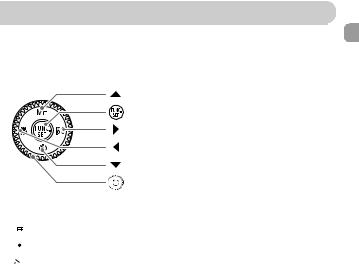
Conventions Used in this Guide
• Icons are used in the text to represent the camera buttons and switches.
•Language that displays on the screen appears inside [ ] (square brackets).
•The directional buttons, control dial, and FUNC./SET button are represented by the following icons.
(Up button)
(FUNC./SET button)
(Right button)
(Left button)
(Down button)
(Control dial)
• : Troubleshooting tips.
: Troubleshooting tips.
• : Hints for getting more out of your camera.
: Hints for getting more out of your camera.
• : Things you should be careful about.
: Things you should be careful about.
• : Supplemental information.
: Supplemental information.
•(p. xx): Reference pages. “xx” stands for page number.
•This guide assumes all functions are at their default settings.
9
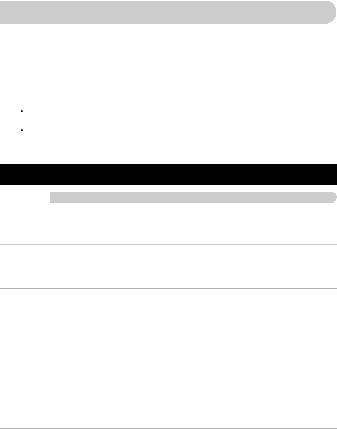
Safety Precautions
•Before using the camera, please ensure that you read the safety precautions described below. Always ensure that the camera is operated correctly.
•The safety precautions noted on the following pages are intended to prevent injuries to yourself and other persons, or damage to the equipment.
•Be sure to also check the guides included with any separately sold accessories you use.
 Warning Denotes the possibility of serious injury or death.
Warning Denotes the possibility of serious injury or death.
 Caution Denotes the possibility of injury.
Caution Denotes the possibility of injury.
Caution Denotes the possibility of damage to the equipment.
 Warning
Warning
Camera
•Do not trigger the flash in close proximity to human eyes.
Exposure to the intense light produced by the flash could damage eyesight. In particular, remain at least one meter (39 inches) away from infants when using the flash.
•Store this equipment out of the reach of children and infants.
Strap: Putting the strap around a child’s neck could result in asphyxiation.
Memory card, day/date battery: Dangerous if accidentally swallowed. If this occurs, contact a doctor immediately.
•Do not attempt to disassemble or alter any part of the equipment that is not expressly described in this guide.
•To avoid the risk of injury, do not touch the interior of the camera if it has been dropped or otherwise damaged.
•Stop operating the camera immediately if it emits smoke, a strange smell, or otherwise behaves abnormally.
•Do not use organic solvents such as alcohol, benzine, or thinner to clean the equipment.
•Do not allow liquids or foreign objects to enter the camera.
This could result in fire or electrical shock.
If liquid or foreign objects come into contact with the camera interior, immediately turn the camera power off and remove the batteries.
•Use only recommended power sources.
Using other power sources could result in fire or electrical shock.
10

Safety Precautions
Battery
•Use only recommended batteries.
•Do not place the batteries near or in direct flame.
•Do not let the batteries come into contact with water (e.g. sea water) or other liquids.
•Do not attempt to disassemble, alter or apply heat to the batteries.
•Avoid dropping or subjecting the batteries to severe impacts.
This may cause explosions or leaks, resulting in fire, injury and damage to the surroundings. In the event that a battery leaks and the eyes, mouth, skin or clothing contacts these substances, immediately flush with water and seek medical assistance.
Other Warnings
•Do not play the supplied CD-ROM(s) in any CD player that does not support data CD-ROMs.
Playing the CD-ROM(s) in an audio CD player (music player) could damage the speakers. It is also possible to suffer hearing loss from listening with headphones to the loud sounds of a CD-ROM played on a music CD player.
 Caution
Caution
•Be careful not to bang the camera or subject it to strong impacts or shocks when hanging it by the strap.
•Be careful not to bump or push strongly on the lens.
This could damage the camera or lead to injury.
•Avoid using, placing or storing the camera in the following places.
-Places subject to strong sunlight.
-Places subject to temperatures above 40 °C (104 °F).
-Humid or dusty areas.
These could cause leakage, overheating or an explosion of the batteries, resulting in electrical shock, fire, burns or other injuries. High temperatures may also cause deformation of the casing.
•The slideshow transition effects may cause discomfort when viewed for prolonged periods.
•When using the flash, be careful not to cover it with your fingers or clothing.
This could result in burns or damage to the flash.
11

Safety Precautions
Caution
•Do not aim the camera at bright light sources (the sun, etc.).
Doing so may cause malfunctions or damage the image sensor.
•When using the camera on a beach or at a windy location, be careful not to allow dust or sand to enter the camera.
This may cause the camera to malfunction.
•In regular use, small amounts of smoke may be emitted from the flash.
This is due to the high intensity of the flash burning dust and foreign materials stuck to the front of the unit. Please use a cotton swab to remove dirt, dust or other foreign matter from the flash to prevent heat build-up and damage to the unit.
•Remove and store the batteries when you are not using the camera.
If the batteries are left inside the camera, damage caused by leakage may occur.
•Before you discard batteries, cover the terminals with tape or other insulators.
Contacting other metal materials in waste containers may lead to fire or explosions.
•When carrying the camera in a bag, close the LCD monitor to face inward to ensure that hard objects to not come into contact with the screen.
Failure to do so may cause malfunctions or damage the LCD monitor.
12
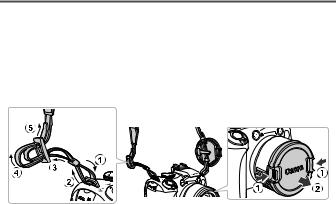
1 
Getting Started
This chapter explains preparations before shooting, how to shoot in A mode, and then how to view, erase and print the images you take. The latter part of this chapter explains how to shoot and view movies and transfer images to a computer.
Attaching the Strap/Removing the Lens Cap
•Attach the included strap and place it around your neck to avoid dropping the camera during use.
•Be sure to remove the lens cap before turning on the camera.
•Clip the lens cap to the neck strap when not in use.
•When not in use, store the camera with the lens cap attached.
13
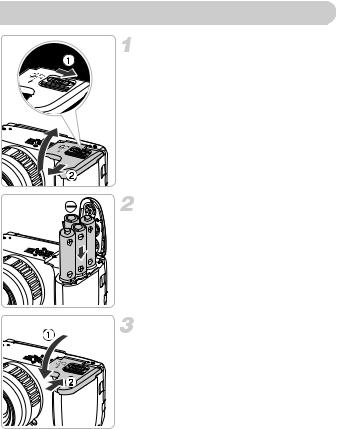
Inserting the Batteries
Open the cover.
● Slide and hold the cover lock  , then slide and open the cover
, then slide and open the cover  as shown.
as shown.
Insert the batteries.
● Insert the batteries with (+) and (–) ends oriented correctly.
Close the cover.
● Close the cover  and press downward as you slide it until it clicks into place
and press downward as you slide it until it clicks into place  .
.
14

|
|
|
Inserting the Batteries |
|
||
Approximate Number of Shots That Can Be Taken |
|
|||||
|
|
|
|
|
|
|
Power Source |
Alkaline Batteries |
|
NiMH Batteries |
|
|
|
(Supplied) |
|
(Sold Separately) |
|
|||
|
|
|
|
|||
Number of |
LCD Monitor On* |
340 |
|
600 |
|
|
Shots |
Viewfinder On |
350 |
|
620 |
|
|
Playback Time (Hours) |
12 |
|
14 |
|
|
|
*The number of shots that can be taken is based on the Camera & Imaging Products Association (CIPA) measurement standard.
•Under some shooting conditions, the number of shots that can be taken may be less than mentioned above.
•Depending on the brand of alkaline batteries used, the number of shots that can be taken may vary widely.
•The values for NiMH batteries are based on fully charged batteries.
Compatible Batteries
AA-size alkaline batteries and Canon AA-size NiMH batteries (sold separately) (pp. 38, 40).
 Can any other batteries be used?
Can any other batteries be used?
We cannot recommend the use of any other batteries than those listed above because performance varies widely.
Why use NiMH batteries?
NiMH batteries last much longer than alkaline batteries, especially in cold weather.
Battery Charge Indicator
When battery charge is low, an icon and message will appear. If the batteries are charged, the icon and message will not display.
Display |
Summary |
|
Battery charge is low. Prepare new batteries to |
|
continue using the camera. |
“Change the batteries” |
The batteries are depleted. Insert new batteries. |
|
|
15
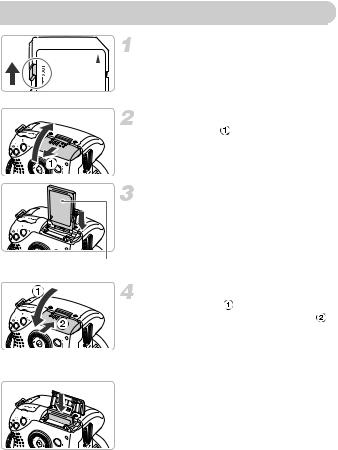
Inserting the Memory Card
|
Check the card’s write-protect tab. |
|
|
● If the memory card has a write-protect tab, |
|
|
you will not be able to record images if the |
|
|
tab is in the locked position. Slide the tab |
|
|
up until you hear a click. |
|
|
Open the cover. |
|
|
● Slide the cover |
to open it. |
|
Insert the memory card. |
|
|
● Insert the memory card as shown until it |
|
|
locks into place with a click. |
|
|
● Be sure the memory card is oriented |
|
|
correctly. Inserting the memory card in the |
|
Label |
wrong direction could damage the |
|
camera. |
|
|
|
|
|
|
Close the cover. |
|
|
● Close the cover |
and press downward |
|
as you slide it until it clicks into place . |
|
Removing the Memory Card 
● Push the memory card in until you hear a click, then slowly release it.
XThe memory card will pop up.
16
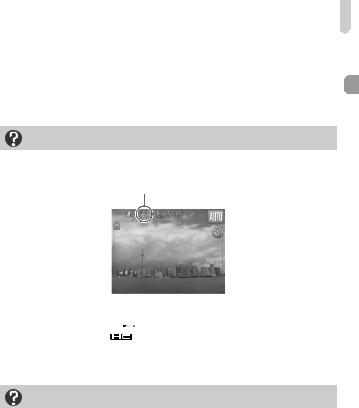
Inserting the Memory Card
Approximate Number of Shots per Memory Card
Memory Card |
2 GB |
8 GB |
Number of shots |
626 |
2505 |
•Values are based on the default settings.
•The number of shots that can be taken will vary depending on camera settings, the subject and the memory card used.
Can you check the number of shots that can be taken?
You can check the number of shots that can be taken when the camera is in a Shooting mode (p. 24).
Number of shots that can be taken
Compatible Memory Cards
•SD memory cards
•SDHC memory cards 
•MultiMediaCards
•MMCplus memory cards
•HC MMCplus memory cards
What is the write-protect tab?
SD and SDHC memory cards have a write-protect tab. If this tab is in the locked position, [Card locked!] will appear on the screen and you will not be able to take or erase images.
17
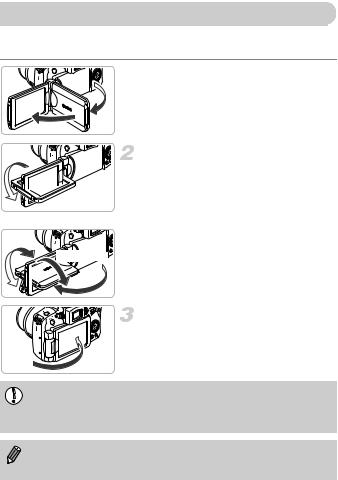
Opening the LCD Monitor
You can use the LCD monitor to compose pictures before shooting, operate menus or play back images.
 Open the LCD Monitor.
Open the LCD Monitor.
Approx.
180°
Rotate the LCD monitor.
● Rotate it 180° toward the lens (turn the top edge of the LCD monitor away from you).
XThe displayed image is automatically flipped and reversed (Reverse Display function).
● The LCD monitor can be used in various
positions.
Approx. 90°
Approx.
170°
Close the LCD Monitor.
● Close the LCD monitor until it clicks into place.
● The image will display normally (not reversed).
Always keep the LCD monitor closed with the display facing the camera body when the camera is not in use. When you push the LCD monitor until you hear the clicking sound, the LCD monitor will automatically turn off, and the image will display in the viewfinder.
To cancel the Reverse Display function, press the n button, choose [Reverse Disp.] from the 4 tab, and press the qr buttons to choose [Off].
18
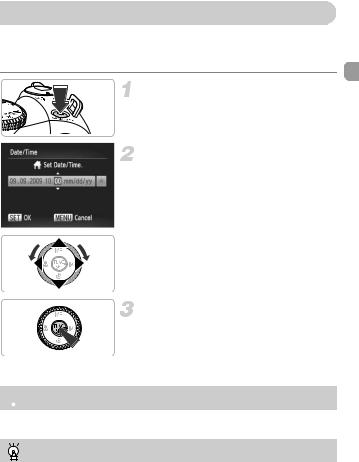
Setting the Date and Time
The Date/Time settings screen will appear the first time the camera is turned on. Since the dates and times recorded into your images are based on these settings, be sure to set them.
Turn on the camera.
● Press the power button.
XThe Date/Time screen will appear.
Set the date and time.
●Press the qrbuttons to choose an option.
●Press the opbuttons or turn the Âdial to set a value.
Make the setting.
● Press the m button.
XOnce the date and time have been set, the Date/Time screen will close.
●Pressing the power button will turn off the camera.
 Reappearing Date/Time screen
Reappearing Date/Time screen
Set the correct date and time. If you have not set the date and time, the Date/ Time screen will appear each time you turn on the camera.
Daylight saving time settings
If you choose  in Step 2 and press the op buttons or turn the  dial and choose
in Step 2 and press the op buttons or turn the  dial and choose  , you will set the time to daylight saving (1 hour ahead).
, you will set the time to daylight saving (1 hour ahead).
19
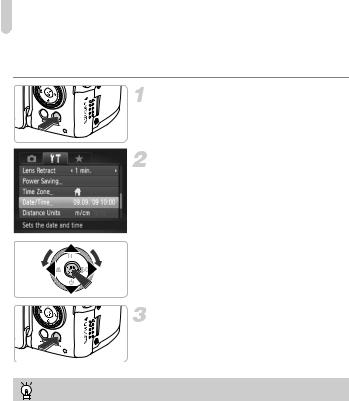
Setting the Date and Time
Changing the Date and Time 
You can change the current date and time settings.
Display the menus.
● Press the nbutton.
Choose [Date/Time] in the 3 tab.
●Press the qrbuttons to choose the 3 tab.
●Press the opbuttons or turn the Âdial to choose [Date/Time], then press the m button.
Change the date and time.
● Follow Steps 2 and 3 on p. 19 to adjust the setting.
● To close the menus, press the n button.
Date/Time battery
If [Date/Time] appear even when the date/time have been correctly set, insert a new date/time battery (p. 156).
20
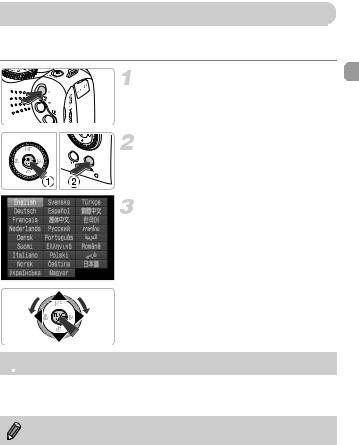
Setting the Display Language
You can change the display language in the LCD monitor menus and messages.
Enter Playback mode.
● Press the 1 button.
Display the settings screen.
● Press and hold the m button  , then immediately press the n button
, then immediately press the n button  .
.
Set the display language.
●Press the opqrbuttons or turn the Â
dial to choose a language, then press the m button.
XOnce the display language has been set, the language menu will close.
 What if the clock appears when the m button is pressed?
What if the clock appears when the m button is pressed?
The clock will appear if too much time passes between pressing the m button and the n button in Step 2. If the clock appears, press the m button to remove the clock and repeat Step 2.
You can also change the display language by pressing the n button, choosing the 3 tab, and choosing the [Language] menu item.
21
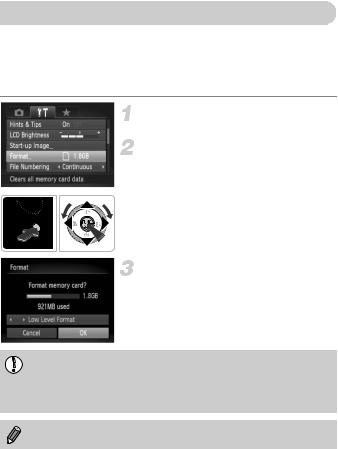
Formatting Memory Cards
Before you use a new memory card or one that has been used in other devices, you should format the card with this camera.
Formatting (initializing) a memory card erases all data on the memory card. As you cannot retrieve the erased data, exercise adequate caution before formatting the memory card.
Display the menu.
● Press the nbutton.
Choose [Format].
●Press the qrbuttons to choose the 3 tab.
●Press the opbuttons or turn the Âdial
to choose [Format], then press the m button.
Format the memory card.
●Press the qrbuttons or turn the Âdial to choose [OK], then press the m button.
XThe memory card will be formatted.
XWhen formatting has finished, the menu screen will reappear.
Formatting or erasing data on a memory card merely changes the file management information on the card and does not ensure its contents are completely erased. Be careful when transferring or disposing of a memory card. When disposing of a memory card, take precautions such as physically destroying the card to prevent personal information leaks.
The total capacity of the memory card displayed in the formatting screen may be less than indicated on the memory card.
22
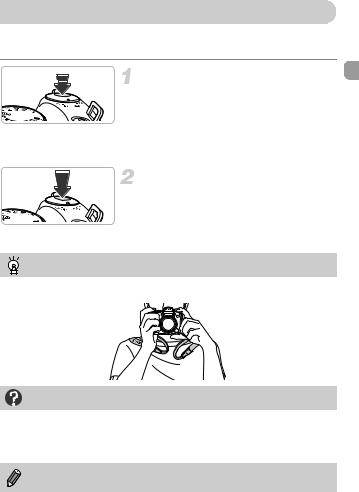
Pressing the Shutter Button
The shutter button has two stops. To take images that are in focus, be sure to first press the shutter button lightly (halfway) to focus, then take the shot.
Press halfway (lightly to the first stop).
XThe camera automatically focuses and selects the necessary settings for shooting, such as the brightness.
XWhen the camera focuses, it will beep twice.
Press fully (to the second stop).
XThe camera plays the shutter sound and takes the shot.
● Since the shot is being taken while the shutter sound plays, be careful not to move the camera.
Holding the Camera
Keep your arms tight against your body while holding the camera firmly by the sides.
Does the length of the shutter sound change?
•Since the time required to shoot differs according to the scene you want to take, the length of the shutter sound may change.
•If the camera or subject moves while the shutter sound is playing, the recorded image may be blurry.
If you just press the shutter button fully without pausing halfway, the image may not be in focus.
23
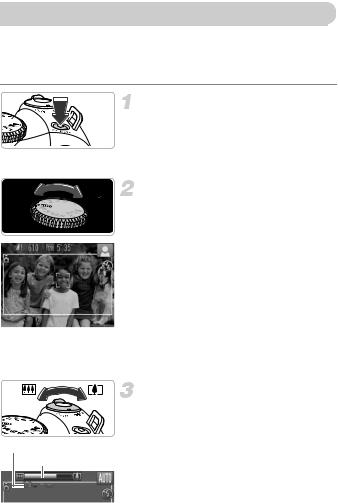
Taking Pictures
Since the camera can determine the subject and shooting conditions, you can let it automatically select the best settings for the scene and just shoot. The camera can also detect and focus on faces, setting the color and brightness to optimal levels.
Image area when shooting movies (p. 27)
Focus range (approx.) Zoom bar
Turn on the camera.
● Press the power button.
XThe start-up sound will play, and the startup screen will appear.
●Pressing the power button again will turn the camera off.
Choose A mode.
●Set the mode dial to A.
●When you point the camera toward the subject, the camera will make a slight noise as it determines the scene.
XThe camera focuses on the subject it judges to be the main subject, and the icon for the determined scene appears in the upper right of the screen.
XWhen faces are detected, a white frame appears on the face of the main subject, while gray frames appear on other detected faces.
XA white frame will follow a detected face that is moving and the gray frames will disappear.
Compose the shot.
●Moving the zoom lever toward iwill
zoom in on your subject, making it appear larger. Moving the lever toward j will zoom out from your subject, making it appear smaller.
●If you move the zoom lever all the way to the left or right the size will change quickly, and if you move it slightly, the size will change slowly.
24

Taking Pictures
Focus.
● Press the shutter button halfway to focus. XWhen the camera focuses, it will beep
twice.
XGreen AF frames appear where the subject is in focus.
XSeveral AF frames will appear when the camera focuses on more than one point.
XWhen a moving face is detected, and you keep the shutter button pressed halfway, a blue AF frame appears and the focus
and exposure are continuously adjusted.
AF Frames
● If the [Raise the flash] message appears, it is recommended to shoot with the flash.
Raise the flash manually to shoot. The
flash will automatically fire. When you are
not using the flash, lower it until it closes (the flash will turn off).
Shoot.
● Press the shutter button fully.
XThe camera will play the shutter sound and shoot.
XThe indicator will blink red while the image is recorded to the memory card.
XThe image will appear on the screen for about two seconds.
●You can take a second picture even while an image is displayed by pressing the shutter button again.
What if...
•a flashing  appears?
appears?
Attach the camera to a tripod so that the camera does not move and blur the image.
•the screen does not turn on when you turn on the camera?
The display is set to the viewfinder. Press the l button several times to restore the display to the screen.
25

Taking Pictures
•the camera does not play any sounds?
Pressing the lbutton while turning on the camera power will turn off all sounds except for warning sounds. To turn the sounds on, press the n button, choose the 3tab, and then choose [Mute]. Press the qrbuttons to choose [Off].
•the image comes out dark even if the flash fired when shooting?
The subject is too far away for the flash to reach. Shoot within the effective flash range of approximately 50 cm – 6.8 m (1.6 – 22 ft.) at maximum wide angle, and approximately 1.0 – 3.7 m (3.3 – 12 ft.) at maximum telephoto.
•the camera beeps once when the shutter button is pressed halfway?
Your subject is too close. When the camera is at maximum wide angle, move about 10 cm (3.9 in.) or more away from your subject and shoot. Move about 1 m (3.3 ft.) or more away when the camera is at maximum telephoto.
•the lamp lights when the shutter button is pressed halfway?
To reduce red-eye and to assist in focusing, the lamp may light when shooting in dark areas.
•the hicon blinks when you try to shoot?
The flash is charging. You can shoot when recharging ends.
Scene Icons
The camera displays an icon for the scene it has determined and then automatically focuses and selects the optimum settings for subject brightness and color.
Bright |
Including Blue |
|
Dark |
|
Skies |
|
|||
|
|
|
||
|
Sunsets |
|
When |
|
Backlit |
Backlit |
|
||
|
Using |
|||
|
|
|
Tripod |
|
People |
– |
|
* |
|
When |
– |
– |
– |
|
Moving |
||||
|
|
|
||
Subjects Other Than |
|
|
* |
|
People/Landscapes |
|
|
||
|
|
|
||
Close Subjects |
– |
|
– |
Icon Background Color |
Gray |
Light Blue |
Orange |
Dark Blue |
* Appears when the camera is attached to a tripod. |
|
|
||
26

Viewing Images
Under certain conditions, the icon that appears may not match the actual scene. Especially when there is an orange or blue colored background (a wall for example), 

 or the “Blue Skies” icons may appear and it may not be possible to shoot with the appropriate color. If this happens, try shooting in G mode (p. 68).
or the “Blue Skies” icons may appear and it may not be possible to shoot with the appropriate color. If this happens, try shooting in G mode (p. 68).
 What is the rectangular gray frame?
What is the rectangular gray frame?
This is the area that will be recorded in a movie. Movies can be shot simply by pressing the movie button, no matter what position the mode dial is in (p. 31). To hide the frame, choose [Custom Display], then [Shooting Info] and remove the check mark (p. 148).
Viewing Images
You can view your images on the screen.
Enter Playback mode.
● Press the 1 button.
XThe last image you took will appear.
Choose an image.
●Pressing the qbutton will cycle through the images in reverse order.
●Pressing the rbutton will cycle through the images in the order they were taken.
●The images change more quickly if you keep the qr buttons pressed, but they will appear coarse.
● Turning the  dial counter-clockwise displays images in reverse order, while turning it clockwise displays images in the order they were taken.
●Pressing the shutter button halfway in Playback mode switches the camera to Shooting mode.
●The lens will retract after approximately 1 minute elapses.
27
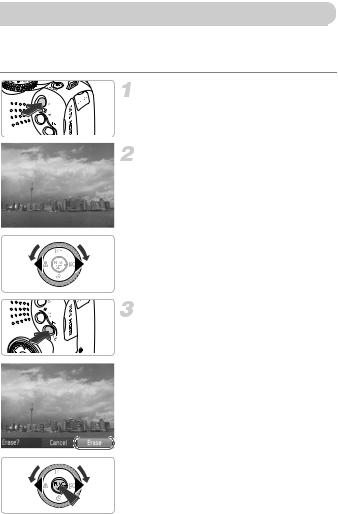
Erasing Images
You can choose and erase images one at a time. Please note that erased images cannot be recovered. Exercise adequate caution before erasing an image.
Enter Playback mode.
● Press the 1 button.
XThe last image you took will appear.
Choose an image to erase.
●Press the qrbuttons or turn the Âdial to display an image to erase.
Erase the image.
● Press the abutton. X[Erase?] appears.
● Press the qrbuttons or turn the Âdial to choose [Erase], then press the m button.
XThe displayed image will be erased.
●To exit instead of erasing, press the qr buttons or turn the  dial to choose [Cancel], then press the m button.
28
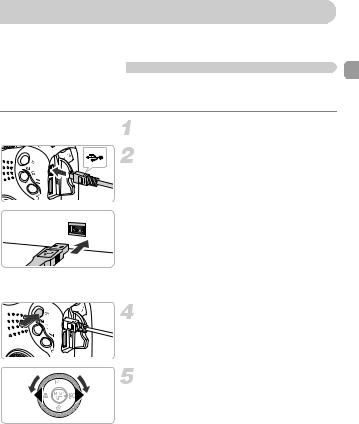
Printing Images
You can easily print the images you have taken if you connect the camera to a PictBridge compliant printer (sold separately).
Items to Prepare
•Camera and PictBridge compliant printer (sold separately)
•Interface cable supplied with the camera (p. 2)
Turn off the camera and printer.
Connect the camera to the printer.
● Open the cover, and insert the small end of the plug firmly into the camera terminal in the direction shown.
● Insert the cable’s larger plug into the printer. For connection details, refer to the user guide provided with the printer.
 Turn on the printer.
Turn on the printer.
Turn on the camera.
● Press the 1button to turn on the camera.
Choose an image to print.
● Press the qrbuttons or turn the Âdial to choose an image.
29
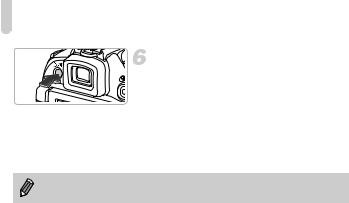
Printing Images
Print images.
● Press the cbutton. XPrinting will start.
● If you want to print additional images, repeat Steps 5 and 6 after printing has completed.
●After printing has completed, turn off the camera and printer, and unplug the interface cable.
• Refer to the Personal Printing Guide for details on printing.
• Refer to p. 39 for Canon-brand Pictbridge compliant printers.
30
